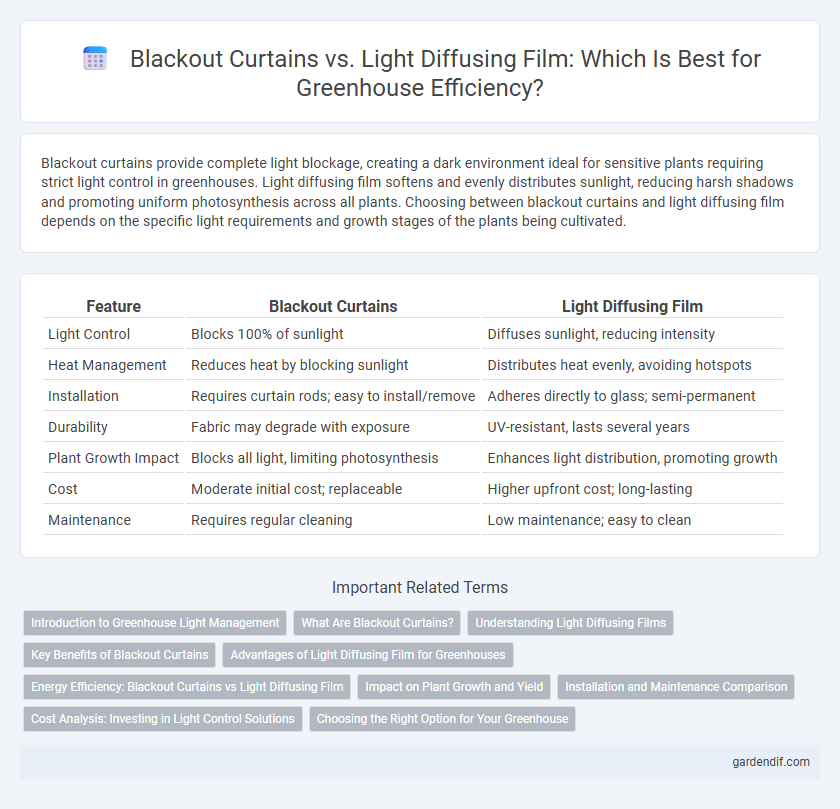
Blackout Curtains vs Light Diffusing Film Illustration
Blackout curtains provide complete light blockage, creating a dark environment ideal for sensitive plants requiring strict light control in greenhouses. Light diffusing film softens and evenly distributes sunlight, reducing harsh shadows and promoting uniform photosynthesis across all plants. Choosing between blackout curtains and light diffusing film depends on the specific light requirements and growth stages of the plants being cultivated.
Table of Comparison
| Feature | Blackout Curtains | Light Diffusing Film |
|---|---|---|
| Light Control | Blocks 100% of sunlight | Diffuses sunlight, reducing intensity |
| Heat Management | Reduces heat by blocking sunlight | Distributes heat evenly, avoiding hotspots |
| Installation | Requires curtain rods; easy to install/remove | Adheres directly to glass; semi-permanent |
| Durability | Fabric may degrade with exposure | UV-resistant, lasts several years |
| Plant Growth Impact | Blocks all light, limiting photosynthesis | Enhances light distribution, promoting growth |
| Cost | Moderate initial cost; replaceable | Higher upfront cost; long-lasting |
| Maintenance | Requires regular cleaning | Low maintenance; easy to clean |
Introduction to Greenhouse Light Management
Effective greenhouse light management is crucial for optimizing plant growth and energy efficiency. Blackout curtains offer complete light blockage, enabling precise control over photoperiods and temperature regulation, which is ideal for certain plant species requiring darkness. In contrast, light diffusing film scatters sunlight uniformly, reducing harsh shadows and promoting even photosynthesis across all plant surfaces.
What Are Blackout Curtains?
Blackout curtains are specially designed window coverings that block nearly 100% of incoming sunlight, creating a dark environment inside greenhouses to control light exposure for sensitive plants. Made from dense, opaque fabrics, these curtains help regulate temperature and prevent unwanted light, ensuring optimal conditions for plant growth and photosensitivity management. Unlike light diffusing film, blackout curtains provide complete light blockage rather than softening or scattering sunlight.
Understanding Light Diffusing Films
Light diffusing films in greenhouses evenly distribute sunlight, reducing harsh shadows and preventing plant stress caused by direct sunlight exposure. These films enhance photosynthesis by scattering light, promoting uniform plant growth while minimizing heat buildup compared to blackout curtains that completely block light. Utilizing light diffusing films supports healthier crop development and more consistent yields by optimizing the quality and intensity of transmitted light.
Key Benefits of Blackout Curtains
Blackout curtains provide superior light control by completely blocking sunlight, which is essential for regulating temperature and preventing heat stress in greenhouse plants. Their thick, opaque fabric enhances energy efficiency by reducing heat gain during hot days and heat loss during cold nights, helping maintain optimal growing conditions. Unlike light diffusing film, blackout curtains offer flexibility for growers to adjust light exposure precisely, supporting plant growth cycles and preventing unwanted light intrusion.
Advantages of Light Diffusing Film for Greenhouses
Light diffusing film enhances greenhouse efficiency by evenly distributing sunlight, reducing hotspots, and promoting uniform plant growth without blocking natural light. This film improves photosynthesis by scattering light, which increases crop yield and quality compared to the localized shading caused by blackout curtains. Unlike blackout curtains that obstruct light entirely, light diffusing film maintains a controlled environment while maximizing light penetration essential for plant development.
Energy Efficiency: Blackout Curtains vs Light Diffusing Film
Blackout curtains provide superior energy efficiency in greenhouses by blocking nearly 100% of incoming light and reducing heat loss during cold nights. In contrast, light diffusing film enhances natural light distribution, promoting uniform plant growth but offers less insulation against temperature fluctuations. Choosing between the two depends on balancing thermal retention needs with optimal light diffusion for photosynthesis.
Impact on Plant Growth and Yield
Blackout curtains create complete darkness, significantly reducing photosynthesis by blocking all light, which can stunt plant growth and lower yield in greenhouses. Light diffusing film disperses sunlight evenly, enhancing light penetration to lower leaves, promoting uniform growth and potentially increasing photosynthetic efficiency and crop yield. Choosing light diffusing film over blackout curtains supports optimal plant development by maintaining essential light levels while preventing localized heat stress.
Installation and Maintenance Comparison
Blackout curtains in greenhouses offer straightforward installation, typically requiring curtain rods or tracks mounted above the structure, and they are easy to remove for cleaning or replacement. Light diffusing film demands professional application directly onto greenhouse glass or polycarbonate panels, ensuring bubble-free adhesion and uniform coverage, which may complicate removal or replacement. Maintenance of blackout curtains involves periodic washing to prevent mold and dust buildup, whereas light diffusing film requires careful inspection for damage and cleaning with non-abrasive solutions to maintain light transmission efficiency.
Cost Analysis: Investing in Light Control Solutions
Blackout curtains typically cost between $30 to $100 per panel, offering a reusable and easily adjustable light control method for greenhouses. Light diffusing film ranges from $1 to $3 per square foot, providing a cost-effective, uniform light distribution solution with longer-term durability. Evaluating upfront costs against maintenance and lifespan helps determine the best investment for optimizing greenhouse light conditions.
Choosing the Right Option for Your Greenhouse
Blackout curtains effectively block sunlight, creating complete darkness to control heat and protect plants sensitive to light cycles, making them ideal for greenhouses requiring strict light management. Light diffusing film evenly disperses sunlight, reducing harsh shadows and preventing plant scorch while promoting uniform growth through softened light distribution. Selecting between these options depends on your greenhouse's specific plant needs, with blackout curtains suited for blackout requirements and light diffusing films perfect for enhancing natural light environment.
Blackout Curtains vs Light Diffusing Film Infographic

 gardendif.com
gardendif.com